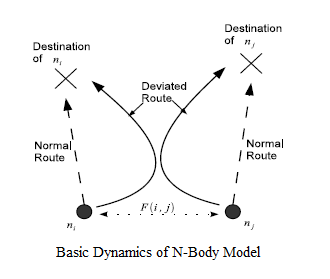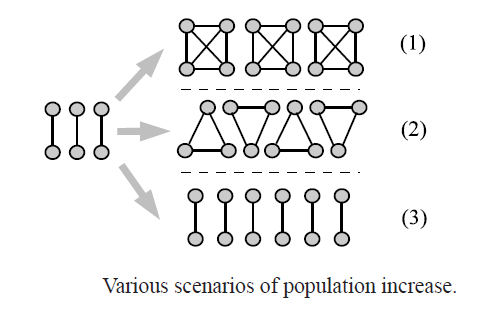In order to achieve a high degree of realism in the proposed mobility model, the influence of mobility parameters to the actual network performance should be well understood. Thus, we conducted a preliminary study on the statistical behavior of contact time (link duration) of random walk and random waypoint models. The purpose of this study is to gain a deeper understanding in the subtlety of the underlying dynamics between the model parameters (like flight length, speed and contact range) and the protocol-independent performance metrics like the contact time.
The focus of this study was on mathematical analysis of contact time distribution in random walk models, in the hope of bridging the gap between two existing approaches: the direct traversal model and the consecutive random walk model. We show that with uniform speed distributions under the direct traversal model the probability density function (PDF) of contact times has a power-law tail, while previous works show an exponential tail under the consecutive random walk model. We conclude that for general random walks with uniform speed distribution, the PDF of contact times has a tail that is actually between the two extremes: a power-law-sub-exponential dichotomy, which degenerates into the extremes as the flight lengths vary. This conclusion is also validated against RWP models.

Human activities are often socially organized, and people are often related to each other through complex inter-personal relationships. Such inter-personal relationships also affect human mobility so that on many occasions people tend to move in groups, rather than individually, e.g., students attending lectures, platoons moving on the battlefield, families walking around at the state fair, or rescue squads searching for victims.
 We studied the group-forming tendency of human movements in mobile ad-hoc networks and surveyed the existing models that generate group movements. Aware of the shortcomings of existing models, we propose the N-Body Mobility Model inspired by N-body simulations. Rather than modeling the underlying social relationship, we simply try to capture the heterogeneity in inter-nodal distances by observing real movement trajectories and reproduce them in the synthesized traces. Inter-nodal attraction and repulsion forces based on modified Gay-Berne potential are implemented as to adjust the inter-nodal distances, and a closed loop framework is used to approach the best parameters. Compared to existing models, the N-body model has the advantage of not requiring any detailed knowledge of the underlying social interaction of the target scenario, therefore has wider scope of application. N-body model is validated against the target traces both from real life and synthesized. Simulation results show that our model is capable of capturing the heterogeneity as observed in the target traces.
We studied the group-forming tendency of human movements in mobile ad-hoc networks and surveyed the existing models that generate group movements. Aware of the shortcomings of existing models, we propose the N-Body Mobility Model inspired by N-body simulations. Rather than modeling the underlying social relationship, we simply try to capture the heterogeneity in inter-nodal distances by observing real movement trajectories and reproduce them in the synthesized traces. Inter-nodal attraction and repulsion forces based on modified Gay-Berne potential are implemented as to adjust the inter-nodal distances, and a closed loop framework is used to approach the best parameters. Compared to existing models, the N-body model has the advantage of not requiring any detailed knowledge of the underlying social interaction of the target scenario, therefore has wider scope of application. N-body model is validated against the target traces both from real life and synthesized. Simulation results show that our model is capable of capturing the heterogeneity as observed in the target traces.
 In N-body model the group metric is presented in the form of an N by N numerical relationship matrix for an N node system. Thus in order to generate a trace for a particular scenario, we need to have a moblity trace of the target scenario containing the same number of nodes beforehand, which significantly limits the application scope of the model. To extend the application scope of the N-body model, we proposed a method to synthesize such relationship matrices for larger populations based on the matrix extracted from a small population. Such an improvement could significantly enhance the applicability of N-body model: in order to synthesize the mobility trace for a particular scenario, we can sample the movement information from a small number of individuals, and use N-body to generate the traces for a much larger population.
In N-body model the group metric is presented in the form of an N by N numerical relationship matrix for an N node system. Thus in order to generate a trace for a particular scenario, we need to have a moblity trace of the target scenario containing the same number of nodes beforehand, which significantly limits the application scope of the model. To extend the application scope of the N-body model, we proposed a method to synthesize such relationship matrices for larger populations based on the matrix extracted from a small population. Such an improvement could significantly enhance the applicability of N-body model: in order to synthesize the mobility trace for a particular scenario, we can sample the movement information from a small number of individuals, and use N-body to generate the traces for a much larger population.
Since the relationship matrices are essentially weighted complete networks, and group-moving tendencies are shown as clusters in these networks, we developed an improved configuration model that generates weighted networks according to given clustering and weight information extracted from sample networks. Our network generation model utilizes distorted weight distribution to accomodate different group growth scenarios, and weight dependent cluster coefficient to quantify the level of clustering. Simulation results show this model is capable of synthesizing such weighted clustered networks under diversified scenarios.